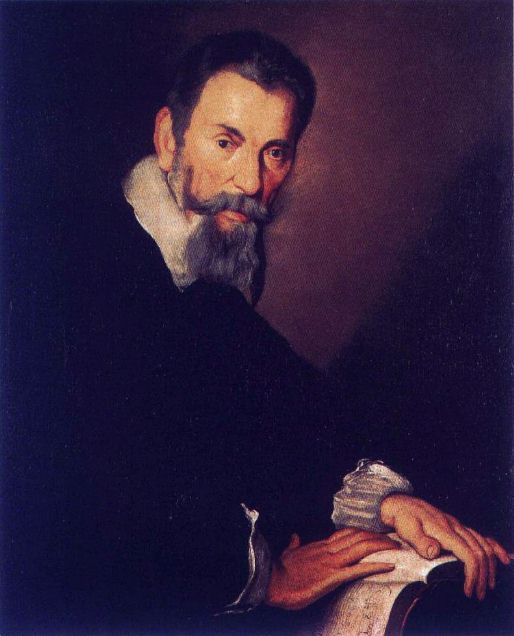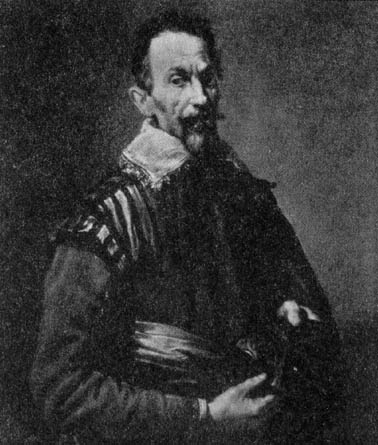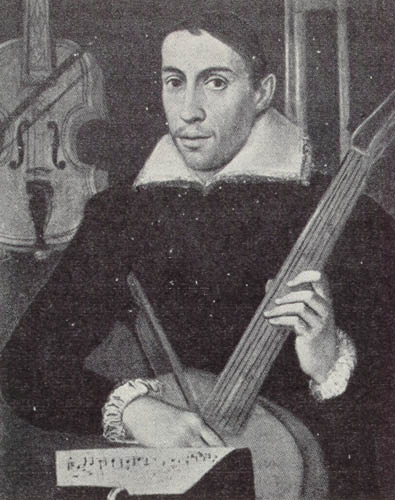

Italian composer. He studied under Marc'Antonio Ingegneri, maestro di cappella of Cremona Cathedral, and published collections of motets, canzonettas, and sacred madrigals while still in his teens. In 1587 his first book of secular madrigals appeared, followed by a second book in 1590. He visited Milan in 1589, and probably performed for the Gonzaga family at Mantua; by 1592 he had obtained an appointment as suonatore di vivuola (viol and/or violin player) to Duke Vincenzo I of Mantua. Monteverdi's third book of madrigals, published in 1592, reveals the strong influence of the court maestro di cappella, Giaches de Wert.  Monteverdi accompanied the duke on a foray against the Turks in Austria and Hungary in 1595, and to Flanders in 1599, where the duke went for a cure. Despite the increasing importance at court that these journeys reveal, he was passed over in 1596 to succeed to Wert's post in favor of Benedetto Pallavicino. Monteverdi married the court singer Claudia de Cattaneis in 1599 and had two sons, Francesco (Baldassare) (bapt. Aug. 27, 1601) and Massimiliano (Giacomo) (bapt. May 10, 1604); a daughter Leonora (Carulla) died in infancy.
Monteverdi accompanied the duke on a foray against the Turks in Austria and Hungary in 1595, and to Flanders in 1599, where the duke went for a cure. Despite the increasing importance at court that these journeys reveal, he was passed over in 1596 to succeed to Wert's post in favor of Benedetto Pallavicino. Monteverdi married the court singer Claudia de Cattaneis in 1599 and had two sons, Francesco (Baldassare) (bapt. Aug. 27, 1601) and Massimiliano (Giacomo) (bapt. May 10, 1604); a daughter Leonora (Carulla) died in infancy.
In 1600 Giovanni Maria Artusi published his L'Artusi, overo Delle imperfettioni della moderna musica ragionamenti dui, which attacked the contrapuntal licences taken by some of Monteverdi's then-unpublished madrigals; Monteverdi's fifth book of madrigals, which appeared in 1605, included a reply to Artusi which was later amplified by Monteverdi's brother Giulio Cesare in the Dichiaratione of the Scherzi musicali (Venice, 1607). His first opera, L'Orfeo, was produced in Mantua in 1607, the same year he was elected to the Accademia degli animosi, Cremona, where part of L'Orfeo may have been performed at one of the meetings.  At first reluctant to return to Mantua after his wife's death in September 1607, Monteverdi relented in order to supervise the production of his second opera, L'Arianna, performed in 1608 to celebrate the homecoming of Francesco Gonzaga with his bride, Margaret of Savoy. He composed two other works for wedding celebrations, the prologue to the pastoral play L'Idropica and the French-style ballet Il ballo delle ingrate.
At first reluctant to return to Mantua after his wife's death in September 1607, Monteverdi relented in order to supervise the production of his second opera, L'Arianna, performed in 1608 to celebrate the homecoming of Francesco Gonzaga with his bride, Margaret of Savoy. He composed two other works for wedding celebrations, the prologue to the pastoral play L'Idropica and the French-style ballet Il ballo delle ingrate.
Exhausted after this intense period of work, he returned to Cremona and spent over a year in a state of depression. His father's request that he be released from the Gonzaga family service was denied, motivating a bitter letter from the composer himself listing his grievances with the Mantuan court. He journeyed to Rome in 1610, apparently in search of a new position, and visited Venice as well. After Duke Vincenzo's death, Monteverdi was dismissed by his successor, Francesco, in July 1612. With the death of the maestro di cappella of St. Mark's, he was invited to compete for the post in 1613, and was appointed later that year at an annual salary of 300 ducats.
In addition to composing some large-scale works, Monteverdi's duties at St. Mark's included reorganizing the cappella, finding new singers, and purchasing music. He received some commissions from Mantua, Duke Francesco having been succeeded by his brother Ferdinando, with whom Monteverdi was well acquainted.  His ballet Tirsi e Clori was performed in Mantua in 1616; two other dramatic works, Le nozze di Tetide and Andromeda, were begun in 1616 and 1618, respectively, but left unfinished. Monteverdi's seventh book of madrigals appeared in 1619, and the following year he refused an offer to return to Mantuan service, alluding to all his old complaints against the Gonzaga household. In 1624 his dramatic dialogue Combattimento di Tancredi e Clorinda was staged at the home of a Venetian nobleman; plans for a full-length opera for Mantua in 1627, La finta pazza Licori, were eventually dropped after he had composed most of the first act. In 1630 Monteverdi set Strozzi's drama Proserpina rapita; an attack of plague in Venice in 1630-31 and the cessation of commissions from Mantua led to the slackening of his compositional activities. He took holy orders in 1632 and published a small collection of vocal music under the title Scherzi musicali the same year. With the opening of public opera houses in Venice in 1637, a new outlet appeared for his dramatic works. L'Arianna was revived in 1640, followed by three new works: Il ritorno d'Ulisse in patria (1640), Le nozze d'Enea con Lavini (1641, lost), and L'incoronazione di Poppea (1643); the ballet La vittoria d'Amore (lost) was commissioned by Pincenza and performed there in 1641. A retrospective collection of his secular music was published in 1638, with a similar volume of church music appearing in 1641. Monteverdi died at the age of 76, shortly after returning to Venice from a trip to Cremona, and was buried in the Church of the Frari.
His ballet Tirsi e Clori was performed in Mantua in 1616; two other dramatic works, Le nozze di Tetide and Andromeda, were begun in 1616 and 1618, respectively, but left unfinished. Monteverdi's seventh book of madrigals appeared in 1619, and the following year he refused an offer to return to Mantuan service, alluding to all his old complaints against the Gonzaga household. In 1624 his dramatic dialogue Combattimento di Tancredi e Clorinda was staged at the home of a Venetian nobleman; plans for a full-length opera for Mantua in 1627, La finta pazza Licori, were eventually dropped after he had composed most of the first act. In 1630 Monteverdi set Strozzi's drama Proserpina rapita; an attack of plague in Venice in 1630-31 and the cessation of commissions from Mantua led to the slackening of his compositional activities. He took holy orders in 1632 and published a small collection of vocal music under the title Scherzi musicali the same year. With the opening of public opera houses in Venice in 1637, a new outlet appeared for his dramatic works. L'Arianna was revived in 1640, followed by three new works: Il ritorno d'Ulisse in patria (1640), Le nozze d'Enea con Lavini (1641, lost), and L'incoronazione di Poppea (1643); the ballet La vittoria d'Amore (lost) was commissioned by Pincenza and performed there in 1641. A retrospective collection of his secular music was published in 1638, with a similar volume of church music appearing in 1641. Monteverdi died at the age of 76, shortly after returning to Venice from a trip to Cremona, and was buried in the Church of the Frari.
Contemporaries and Collaborators
- Monteverdi and "Seconda Prattica"
- Alessandro Striggio 2
- Giulio Strozzi [Luigi Zorzisto]
- Giovanni Maria Artusi
Supplemental Materials
- Monteverdi and "Seconda Prattica"
- Monteverdi's Autograph of Lamento d'Arianna
- Monteverdi's Manuscript of L'Inconronazione di Poppea
- L'Orfeo (First edition)
- L'Orfeo Libretto
Poetry and ProseArticles